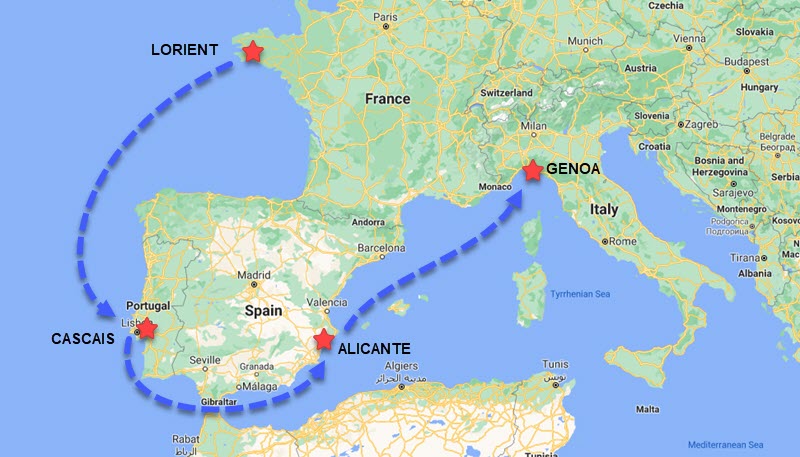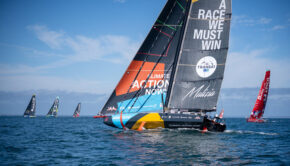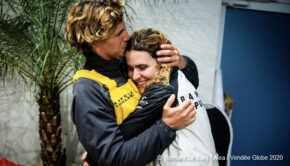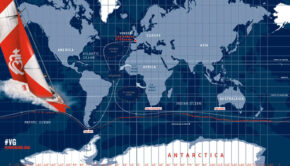One foil, Two boats for 11th Hour Racing
Published on June 21st, 2021
The 2021 Ocean Race Europe provided a bridge event for 2022-23 The Ocean Race (formerly Volvo Ocean Race) which was postponed one year due to COVID-19. It gave full-crew teams in the one-design VO65 and IMOCA 60 an opportunity to either build sponsor interest for the following year, or for teams further along, a chance to progress their training.
11th Hour Racing Team is in the latter category, but skipper Charlie Enright had a struggle keeping his IMOCA from collisions during the three stage offshore event. After hitting a competitor near the Leg 1 finish, his team clipped their port foil on an anchor line after the Leg 2 start, forcing them to return to port and remove it for the remainder of The Ocean Race Europe.
The American sponsored IMOCA thus sailed both Leg 2 and 3, plus one of the two inshore races, with only one foil. How did they still finish second in their class? Considering Offshore Team Germany won the class with no side foils, it was more about horses for courses.
While IMOCA foils start working at 13-14 knots, lifting the hull out of the water as it accelerates through to 18 knots, up to top speeds of 35+ knots, in the light breezes and when sailing upwind, foils are not necessarily a useful asset for generating speed. And the Ocean Race Europe had plenty of that.
When not generating lift, the side foils create drag which slows down the boat. If you were designing a boat for these conditions specifically, it would look quite a bit different from a current generation foiling IMOCA. As a result, the non-foiling Offshore Team Germany enjoyed the upwind conditions and sailing faster than the four, foiling IMOCA 60s.
But how does a boat still be sailed with one foil?
“The guys hit 30 knots shortly after leaving Cascais on Leg 2 of The Ocean Race Europe, with that one starboard foil,” explains Justin Shaffer, who heads up Special Projects for the Team.
“One foil can still lift the boat and the boat can go just as fast – however, in this race it is only possible on this one tack, on the starboard side. On the other tack, they are sailing in a totally different mode.”
So in effect, two boats in one, with unique features on each side – sounds complicated? Well, it certainly is complex. As a matter of fact, the experience of sailing an IMOCA without foils to one with them is very different, particularly at higher wind strengths.
However, when looking at the racecourse of The Ocean Race Europe and the weather conditions the crew faced during a major part of the racecourse, the missing foil became less of an issue.
With a large portion of the race taking place in the Mediterranean Sea, the fleet faced very light wind conditions with a lot of upwind sailing, juggling thermal breezes switching from land to sea when the day begins, and vice versa at night.
To bring on a strong performance in the Med, it was more crucial to play the shifts and outthink the competition in finding the best of the gradient breeze. In this case, the IMOCAs rely much more on their sails than the hydrofoils to maintain optimum speed.
But even when the conditions allowed the benefit of the starboard, 11th Hour Racing Team lacked the righting moment benefit from the missing port foil.
“When sailing IMOCAs, removable water ballast traditionally plays a more important role in generating the righting moment,” explained Shaffer. “However, with the addition of foils, we can use less water ballast than we did previously.
“In some sense, in our current configuration with one foil on one side, we have half of an older generation boat, and half of a newer generation boat, and we sail differently on each tack because of this.”
The experience may prove valuable as 11th Hour Racing Team prepares to launch their new boat by late July with plans to race both boats in the Rolex Fastnet Race in August, the Défi Azimut in September, and the Transat Jacques Vabre in November.
Race details – Tracker – Scoreboard – Facebook
The Ocean Race Europe was a new event on the offshore sailing calendar, open to the one-design VO65 class and teams sailing in a fully-crewed configuration in the IMOCA 60s. The Ocean Race Europe was providing a bridge event for 2022-23 The Ocean Race (formerly Volvo Ocean Race) which was postponed one year due to COVID-19.
As well as the three equally scored offshore legs totaling 2000 nm – Leg 1: Lorient to Cascais, Portugal (starts May 29); Leg 2 Cascais to Alicante, Spain (starts June 6); and Leg 3 Alicante to Genova, Italy (starts June 13) – the teams also raced two shorter coastal races in Cascais and Genova with bonus points awarded to the top three.
Source: 11th Hour Racing Team










 We’ll keep your information safe.
We’ll keep your information safe.